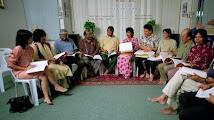Here from India's department of education.
Education for peace is different from peace education. In the latter, peace is a subject in the syllabus. In the former, peace becomes the shaping vision of education. This implies a paradigm shift in the total transaction of education. Currently, the enterprise of education is driven by market forces. Education for peace is not antagonistic to the market, but it does not recognise the market as the purpose of education. The market is only a part of our life-world. Education for peace is education for life, and not merely training for a livelihood. Equipping individuals with the values, skills, and attitudes they need to be wholesome persons who live in harmony with others and as responsible citizens is the goal of education for peace.Read the full article here.
(National Focus Group on Education for Peace, India, p. 1)
Dictums:
Training in morals and good conduct is far more important than book learning. A child that is cleanly, agreeable, of good character, well-behaved—even though he be ignorant—is preferable to a child that is rude, unwashed, ill-natured, and yet becoming deeply versed in all the sciences and arts. The reason for this is that the child who conducts himself well, even though he be ignorant, is of benefit to others, while an ill-natured, ill-behaved child is corrupted and harmful to others, even though he be learned. If, however, the child be trained to be both learned and good, the result is light upon light.
('Abdu'l-Bahá, SWA 135-6)
[T]he primary challenge in dealing with issues of peace is to raise the context to the level of principle, as distinct from pure pragmatism. For, in essence, peace stems from an inner state supported by a spiritual or moral attitude, and it is chiefly in evoking this attitude that the possibility of enduring solutions can be found.
(The Universal House of Justice, The Promise of World Peace, p. 9)
Photo source is here.






No comments:
Post a Comment